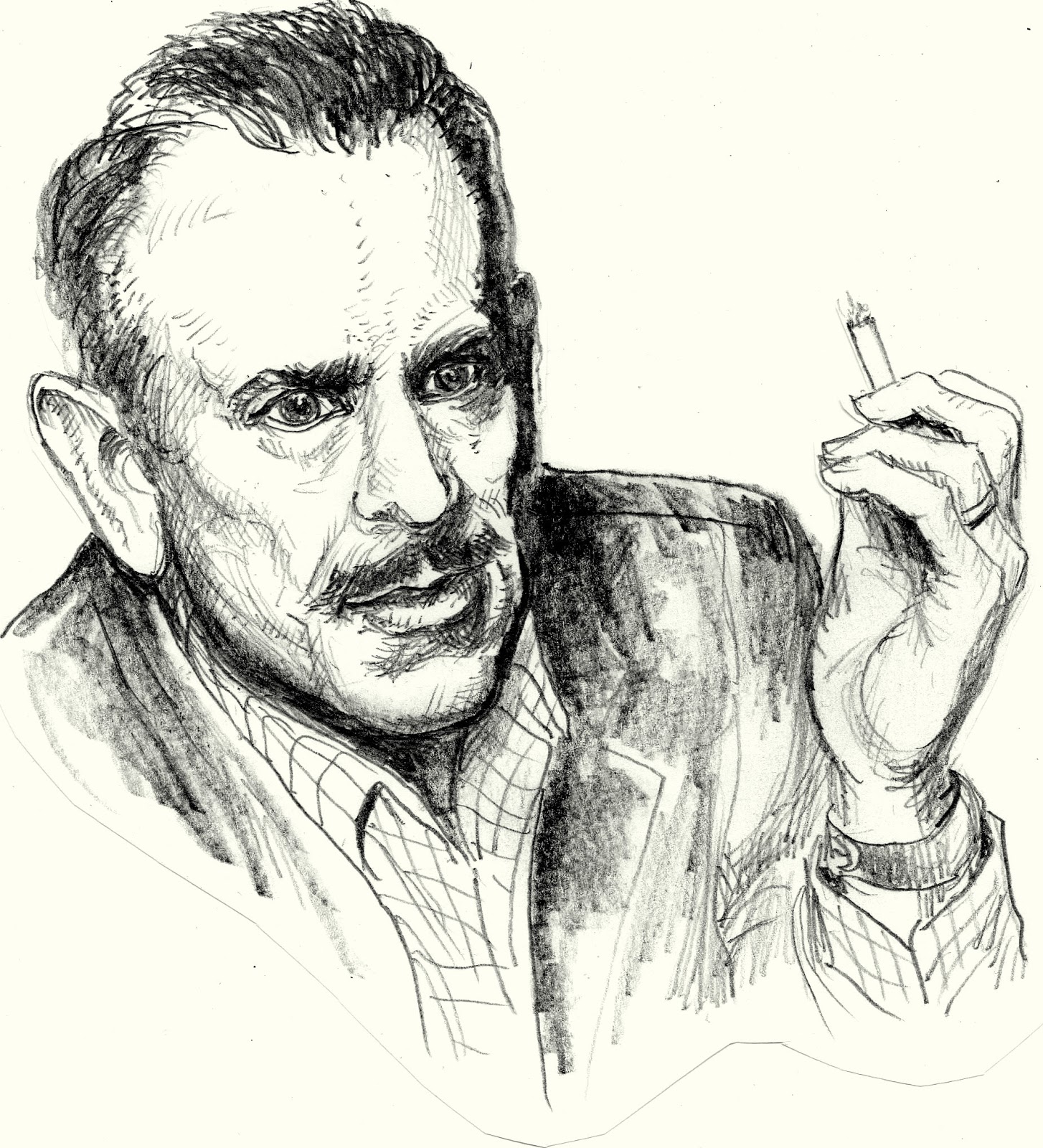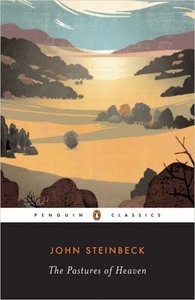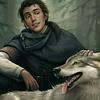Take a photo of a barcode or cover
adventurous
dark
funny
fast-paced
Plot or Character Driven:
Character
Strong character development:
Complicated
Loveable characters:
No
Diverse cast of characters:
No
Flaws of characters a main focus:
Complicated
[b:The Pastures of Heaven|186369|The Pastures of Heaven|John Steinbeck|https://i.gr-assets.com/images/S/compressed.photo.goodreads.com/books/1390254507l/186369._SY75_.jpg|1508574] by [a:John Steinbeck|585|John Steinbeck|https://images.gr-assets.com/authors/1182118389p2/585.jpg]

Steinbeck takes the reader on an epic journey from the purest aspects of the human soul to its darkest corners in the interconnected short stories that were set in a valley. After the discovery of the valley, some came here with ideas in their minds for a living. And others to escape from their past. Misconceptions, emotional weaknesses, and intellectual disability were put into the stories. Moreover, the residents of the valley, who lead seemingly ordinary lives, moved step by step towards their personal disasters and frustrations in each tale.
Powerful read.

Steinbeck takes the reader on an epic journey from the purest aspects of the human soul to its darkest corners in the interconnected short stories that were set in a valley. After the discovery of the valley, some came here with ideas in their minds for a living. And others to escape from their past. Misconceptions, emotional weaknesses, and intellectual disability were put into the stories. Moreover, the residents of the valley, who lead seemingly ordinary lives, moved step by step towards their personal disasters and frustrations in each tale.
Life is so unreal. I think that we seriously doubt that we exist and go about trying to prove that we do.
Powerful read.
Steinbeck is often such a bummer and this was no exception but something about these little sad vignettes was so enjoyable. This is my favorite Steinbeck novel so far. I’d love to reread it sometime and map out the townspeople as I go (especially Burt’s involvement in all the stories).
This collection of interlinking stories about the valley known as the Pastures of Heaven is fascinating, and written in the thought-provoking and humorous prose that only Steinbeck can provide.
I can't even think of a full review. Short stories as a whole aren't my thing. Here, I enjoyed them. That's already quite impressive.
I've been reading this for about a year, taking it page by page. In a way, finishing this book is strange because I'm so used to carrying it around in my backpack, to opening it while waiting in lines. I feel like I've spent the last year living my life and occasionally visiting these characters.
And now that it's over, I don't know what to do. It's a good book. I liked Of Mice and Men more but this is definitely an amazing book. The author manages to take me with him. That's incredible to me. I cared. Not about all the characters but Helen's story made me tear up, I was awed when I finished Shark's story, the epilogue made me go "fuck, he did not just do that".
All in all, I definitely recommend this even if I am not sure what I will remember of this book in a few weeks. It's not a very vivid book but it's quite penetrating.
what I'm taking with me:
• Heaven is totally a lie.
• How to create a map of characters, to weave characters into short stories.
• Life kinda sucks.
I've been reading this for about a year, taking it page by page. In a way, finishing this book is strange because I'm so used to carrying it around in my backpack, to opening it while waiting in lines. I feel like I've spent the last year living my life and occasionally visiting these characters.
And now that it's over, I don't know what to do. It's a good book. I liked Of Mice and Men more but this is definitely an amazing book. The author manages to take me with him. That's incredible to me. I cared. Not about all the characters but Helen's story made me tear up, I was awed when I finished Shark's story, the epilogue made me go "fuck, he did not just do that".
All in all, I definitely recommend this even if I am not sure what I will remember of this book in a few weeks. It's not a very vivid book but it's quite penetrating.
what I'm taking with me:
• Heaven is totally a lie.
• How to create a map of characters, to weave characters into short stories.
• Life kinda sucks.
excellent book even though being steinbeck's earlier book
In 1919, Sherwood Anderson published a collection of short stories centering around a town. The book was called Winesburg, Ohio. It remained popular into the 1930s. Around this time, a young journalist named Elizabeth Ingels developed an idea of interconnected stories similar to Anderson's work, but based in California. She mentioned the idea to a young writer named John Steinbeck. At the time, Steinbeck was struggling with his first novel (the later published To a God Unknown) and had managed to publish his second (the cringe-worthy Cup of Gold). He had yet to find his voice and his readers. So he did what any young, unappreciated artist has at least struggled with—he borrowed a good idea.
Now I've heard the argument from some of Steinbeck's devoted fans and scholars: Steinbeck's idea was unique from Ingels' original concept... Ingels wasn't ever going to do anything with the idea anyway... whatever. It doesn't matter and here's why: this book kind of sucks (relatively speaking, anyway). No, some people love it. Many do in fact. I didn't. I consider this one of the author's worsts. This is the twenty-second book I've read of Steinbeck's and, well, personally, Burning Bright made a bigger impact on me. Burning Bright? The experimental one about circus clowns and farmers and sailors? Yes, that one.
What the casual reader of Steinbeck may not know is that the author's earliest works are often far from the realism that Steinbeck is generally known for. The author repeatedly tried to separate himself from this label, a categorization that was cemented with works such as In Dubious Battle and The Grapes of Wrath. This spiritual, magical Steinbeck is most evident in the author's earliest books and latest books. Sometimes these subtle elements of magic worked for the author, other times they didn't; largely, they're either missed or ignored.
The Pastures of Heaven holds some of this early Steinbeck magic. Sometimes it works, other times it doesn't. Either way, the collection as a whole has a rather absurd feel to it. Curses, gnomes, and sex-dealing proprietors of a Mexican restaurant who take “buy one, get one free” to a new level... yet, it's all Steinbeck. The author didn't spend as much time with the setting as he did in later works, but his signature style of laying out the scenery and breathing life into it is intact.
But where The Pastures of Heaven succeeds most is in its characters. I would argue that, amongst Steinbeck's earliest works, this is one of his most character-centric books. These are brief character studies of the people who populate the valley. In these short pieces, no character is given the time to be developed fully, however. Aside from some of the characters, and a couple stories, there's nothing horribly exciting about this collection. Compared to Steinbeck's greatest works, nothing in these stories stands out. Compared to the town of Winesburg, Ohio, however, Las Pasturas del Cielo, California, is much more spellbinding.
Now I've heard the argument from some of Steinbeck's devoted fans and scholars: Steinbeck's idea was unique from Ingels' original concept... Ingels wasn't ever going to do anything with the idea anyway... whatever. It doesn't matter and here's why: this book kind of sucks (relatively speaking, anyway). No, some people love it. Many do in fact. I didn't. I consider this one of the author's worsts. This is the twenty-second book I've read of Steinbeck's and, well, personally, Burning Bright made a bigger impact on me. Burning Bright? The experimental one about circus clowns and farmers and sailors? Yes, that one.
What the casual reader of Steinbeck may not know is that the author's earliest works are often far from the realism that Steinbeck is generally known for. The author repeatedly tried to separate himself from this label, a categorization that was cemented with works such as In Dubious Battle and The Grapes of Wrath. This spiritual, magical Steinbeck is most evident in the author's earliest books and latest books. Sometimes these subtle elements of magic worked for the author, other times they didn't; largely, they're either missed or ignored.
The Pastures of Heaven holds some of this early Steinbeck magic. Sometimes it works, other times it doesn't. Either way, the collection as a whole has a rather absurd feel to it. Curses, gnomes, and sex-dealing proprietors of a Mexican restaurant who take “buy one, get one free” to a new level... yet, it's all Steinbeck. The author didn't spend as much time with the setting as he did in later works, but his signature style of laying out the scenery and breathing life into it is intact.
But where The Pastures of Heaven succeeds most is in its characters. I would argue that, amongst Steinbeck's earliest works, this is one of his most character-centric books. These are brief character studies of the people who populate the valley. In these short pieces, no character is given the time to be developed fully, however. Aside from some of the characters, and a couple stories, there's nothing horribly exciting about this collection. Compared to Steinbeck's greatest works, nothing in these stories stands out. Compared to the town of Winesburg, Ohio, however, Las Pasturas del Cielo, California, is much more spellbinding.
The Pastures of Heaven is John Steinbeck’s 1932 collection of twelve intertwining short stories set in a fertile valley near Salinas and Monterey, California. As time passes, the characters, all of whom know each other in the way that people in small communities usually do, come and go as their individual stories and fates unfold. Some set their roots so deeply that they and their descendants will be there forever, but others are only there long enough for some personal tragedy or failure to send them on their way.
In the collection’s second story, one Bert Battle, a man with a history of personal failure, comes to the valley to take over a farm that locals believe is both cursed and haunted. Bert, though, makes such a success of the farm that he is soon accepted into the community and even becomes one of the most influential citizens in the entire valley. Reflecting upon his great success at the valley’s general store one day, Bert remarks, “Maybe my curse and the farm’s curse got to fighting and killed each other off.” This leads the storekeeper to make a prophetic observation of his own, one that sets the tone for the rest of the book: “Maybe your curse and the farm’s curse have mated and gone into a gopher hole like a pair of rattlesnakes. Maybe there’ll be a lot of baby curses crawling around the Pastures the first thing we know.”
It was only a joke on the storekeeper’s part – but that is exactly what would happen.
Several of Steinbeck’s stories are about dreamers who cannot resist the lure of the valley’s beauty and tranquility. They come seeking shelter but find that their personal failings travel to the valley with them. One man tries to raise his little boy in a kind of isolated poverty he believes will give the child an untainted life of the mind, only to watch his world crumble when school authorities demand that his son attend public school. A woman comes to town with her mentally disturbed daughter hoping that the solitude will be good for both of them; an abandoned baby is found and taken into the care of a local rancher; two sisters decide to supplement their income by opening up a home business; and a new schoolteacher comes to town hoping to leave her family’s past behind her for good. And it does not end well for any of them.
Along the way, a few dreams do seem to come true. But those “baby curses” are always out there waiting to destroy those who dare to dream, especially those who dare to dream as big as the protagonist of the collection’s next-to-last story (the stories are numbered, not titled separately). Richard Whiteside came to the West to start a family dynasty and he immediately went to work building the family home that he envisioned would anchor the Whitesides there for many generations to come. But Richard’s personal “baby curse” just smiled and waited in the background.
The Pastures of Heaven is certainly not an optimistic short story collection, but readers of the book will get a preview of many of the themes that would influence John Steinbeck’s work throughout the rest of his career.
In the collection’s second story, one Bert Battle, a man with a history of personal failure, comes to the valley to take over a farm that locals believe is both cursed and haunted. Bert, though, makes such a success of the farm that he is soon accepted into the community and even becomes one of the most influential citizens in the entire valley. Reflecting upon his great success at the valley’s general store one day, Bert remarks, “Maybe my curse and the farm’s curse got to fighting and killed each other off.” This leads the storekeeper to make a prophetic observation of his own, one that sets the tone for the rest of the book: “Maybe your curse and the farm’s curse have mated and gone into a gopher hole like a pair of rattlesnakes. Maybe there’ll be a lot of baby curses crawling around the Pastures the first thing we know.”
It was only a joke on the storekeeper’s part – but that is exactly what would happen.
Several of Steinbeck’s stories are about dreamers who cannot resist the lure of the valley’s beauty and tranquility. They come seeking shelter but find that their personal failings travel to the valley with them. One man tries to raise his little boy in a kind of isolated poverty he believes will give the child an untainted life of the mind, only to watch his world crumble when school authorities demand that his son attend public school. A woman comes to town with her mentally disturbed daughter hoping that the solitude will be good for both of them; an abandoned baby is found and taken into the care of a local rancher; two sisters decide to supplement their income by opening up a home business; and a new schoolteacher comes to town hoping to leave her family’s past behind her for good. And it does not end well for any of them.
Along the way, a few dreams do seem to come true. But those “baby curses” are always out there waiting to destroy those who dare to dream, especially those who dare to dream as big as the protagonist of the collection’s next-to-last story (the stories are numbered, not titled separately). Richard Whiteside came to the West to start a family dynasty and he immediately went to work building the family home that he envisioned would anchor the Whitesides there for many generations to come. But Richard’s personal “baby curse” just smiled and waited in the background.
The Pastures of Heaven is certainly not an optimistic short story collection, but readers of the book will get a preview of many of the themes that would influence John Steinbeck’s work throughout the rest of his career.
This is some of my favorite I've read from Steinbeck. I think the interlocking short story form suits his writing style and the settings he uses for his stories perfectly. In this book, each chapter is a semi-unrelated story of a person or family who lives in the Pastures of Heaven, a town outside of Monterey in the Central Valley.
My perpetual problem with Steinbeck is that even in his novels, I always feel like his devotion to describing land and place overshadows our connection to the characters themselves. But in this short story form, with the land itself as the common feature between the various characters, that becomes a strength of the book. And in fact, it allows Steinbeck to explore many different types of characters: a vast array from traditional farming families, to women forced into prostitution to help their business, to a child born with a strange connection with the land -- all of them resilient and drawn in full color.
My perpetual problem with Steinbeck is that even in his novels, I always feel like his devotion to describing land and place overshadows our connection to the characters themselves. But in this short story form, with the land itself as the common feature between the various characters, that becomes a strength of the book. And in fact, it allows Steinbeck to explore many different types of characters: a vast array from traditional farming families, to women forced into prostitution to help their business, to a child born with a strange connection with the land -- all of them resilient and drawn in full color.




